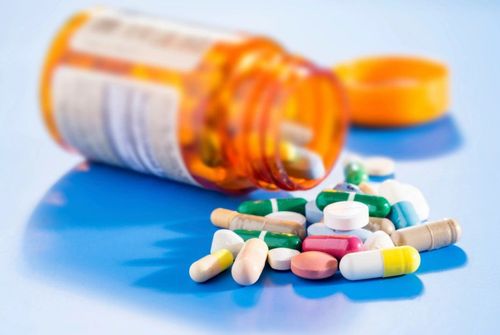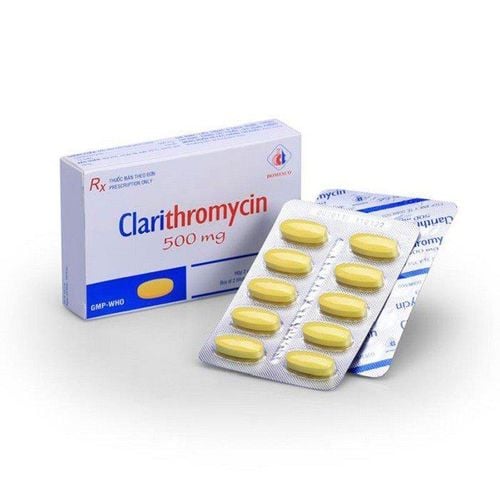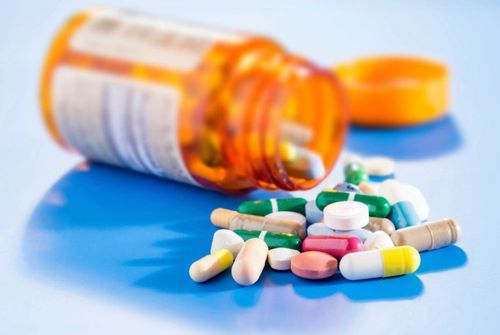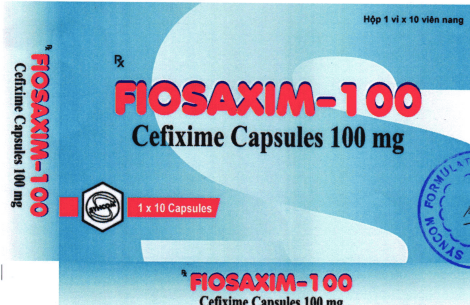This is an automatically translated article.
Hafixim 100 is an antibiotic with bactericidal effect, the drug is often indicated in upper and lower respiratory tract infections, urinary tract infections, gonorrhea. To ensure the effectiveness of treatment and avoid side effects, users need to strictly follow the instructions of the doctor, professional pharmacist.
1. What is Hafixim 100?
Hafixim 100 has the main active ingredient Cefixim, which is prepared in the form of a powder for oral suspension with a concentration of 100mg. Cefixime is a 3rd generation cephalosporin antibiotic with bactericidal action. Cefixime's bactericidal mechanism is to bind to target proteins that inhibit the synthesis of mucopeptides in the bacterial cell wall.
Antibacterial spectrum of Cefixime:
Gram-positive aerobic bacteria: Streptococcus pyogenes, Streptococcus agalactiae, Streptococcus pneumoniae. Gram-negative aerobic bacteria: Neisseria meningitidis, N. gonorrhoeae secrete or do not secrete penicillinase. Cefixim is active in vitro against the majority of beta-lactamase-producing or non-secreting Haemophilus influenzae and Haemophilus parainfluenzae, Moraxella catarrhalis, most clinically important Enterobacteriaceae, many strains of E. Coli, Citrobacter freundii, K. pneumoniae and P. mirabilis resistant to other antibiotics, Salmonella typhi. Drug resistance:
Cefixime is highly stable, not hydrolyzed by many plasmid and chromosomal-mediated beta-lactamases, but hydrolyzed by some beta-lactamases of Klebsiella oxytoca, Enterobacter, Proteus vulgaris... One In some strains of Morganella morganii, Cefixim stimulates beta-lactamase production, but the drug remains active in vitro against those strains. Staphylococci are resistant to the drug because Cefixime has a weak affinity for staphylococcal PBP2. Cefixime also has a poor affinity for Enterococcus and Listeria monocytogenes PBPs, making them resistant to these agents. Citrobacter freundii and Enterobacter are resistant to Cefixime: by secreting beta-lactamases and factors that prevent drug penetration into bacteria. Acinetobacter and Pseudomonas drug resistance is due to factors that permeate the bacterial cell membrane. Cefixime has no in vitro activity against Staphylococci (secreting or not secreting beta-lactamases) such as Staphylococcus epidermidis, Staphylococcus aureus, and Staphylococcus saprophyticus, oxacillin-resistant Staphylococci. Most strains of Staphylococci, Enterococci and Listeria are no longer susceptible to cefixime. Enterobacter, Pseudomonas aeruginosa and Bacteroides were resistant to Cefixim. Cefixime has limited in vitro activity against anaerobic bacteria; most strains of Clostridia are already resistant. Gram-negative aerobic bacteria such as Flavobacterium meningosepticum and Achromobacter xylosoxidans were resistant to Cefixim.
2. What are the effects of Hafixim 100?
2.1.Indications of the drug Hafixim 100 Hafixim 100 is indicated for the treatment of upper and lower respiratory tract infections, urinary tract infections, gonorrhea... specifically as follows:
Otitis media causes by Moraxella catarrhalis, Haemophilus influenzae, Streptococcus pyogenes. Acute otitis media caused by Haemophilus influenzae (including beta-lactamase-producing strains), Moraxella catarrhalis, Streptococcus pyogenes. Pharyngitis, tonsillitis caused by Streptococcus pyogenes. Acute and chronic bronchitis caused by Streptococcus pneumoniae, Haemophilus influenzae, Moraxella catarrhalis. Mild to moderate pneumonia, including community-acquired pneumonia. Uncomplicated urinary tract infections caused by susceptible strains of E. coli or Proteus mirabilis. A limited number of cases of uncomplicated urinary tract infections caused by other Gram-negative bacilli such as Citrobacter, Enterobacter, Klebsiella, Proteus. Nephritis - pyelonephritis, complicated urinary tract infections caused by susceptible Enterobacteriaceae. Uncomplicated gonorrhea is caused by Neisseria gonorrhoeae. Typhoid is caused by Salmonella typhi, including multi-drug resistant strains. Diseases caused by susceptible Shigella, including ampicillin-resistant strains. Antibiotics may be given before the results of the antibiogram are available if the causative agent is suspected. However, in order to have the best treatment effect, it is necessary to isolate bacteria and make an antibiotic map, adjust the regimen as soon as the results are available.
2.2.Contraindications Allergy or hypersensitivity to any component of the drug Hafixim. History of hypersensitivity to Cefixime or other cephalosporin antibiotics, anaphylaxis due to penicillin.
3. How to take Hafixim 100
Mix medicine with about 5-10ml of water for 1 pack of medicine. Patients need to stir the medicine well before taking it and use it immediately after it has been mixed. Hafixim can be taken before or after meals.
3.1.Dose of medicine Hafixim 100 usually takes 5-10 days. The duration of therapy is adjusted depending on the causative agent, and should be continued for an additional 48-72 hours after the symptoms of infection have resolved. If the infection is caused by group A beta-hemolytic Streptococcus, it must be used for at least 10 days. Lower respiratory tract infections and otitis media require treatment for 10-14 days.
Children under 6 months of age: the effectiveness and safety of the drug has not been fully studied. Children from 6 months to 12 years old: dose 8mg/kg/day, taken once/day or divided into 2 times/day 12 hours apart. Children over 12 years old and adults: 400mg/day, once/day or divided into 2 times/day 12 hours apart. Uncomplicated gonorrhea caused by Neisseria gonorrhoeae (including beta-lactamase-producing strains): 400mg single dose. In some cases, the dose of Cefixime can be higher than 800mg. Renal impairment, dose adjustment is required depending on the degree of renal failure:
Creatinine clearance > 60 ml/min: No dose adjustment of Hafixim is required. Creatinine clearance 21-60ml/min: dose 300mg/day, Creatinine clearance <20ml/min: 200mg/day dose. Cefixime is not lost through hemodialysis, so patients on hemodialysis and peritoneal dialysis do not need additional doses of Cefixime. 3.2.Overdose and management Symptoms of overdose may appear convulsions. When symptoms of overdose appear, it is necessary to stop using the drug and immediately go to a medical facility for timely treatment. Symptomatic treatment is mainly: gastric lavage, anticonvulsant drugs if clinically indicated.
4. Undesirable effects when taking Hafixim 100
Cefixime is generally well tolerated, side effects are usually transient, of mild to moderate severity. The rate of patients using the drug experiencing unwanted effects is about 50%, but only 5% of patients have to stop taking the drug. Some undesirable effects when using Hafixim 100 are:
Digestion: digestive disorders, diarrhea and broken stools, abdominal pain, vomiting, nausea, flatulence, loss of appetite, dry mouth. Gastrointestinal disturbances usually occur during the first 1-2 days of dosing and respond to symptomatic medications. Patients rarely have to stop taking the drug due to digestive disorders. Less common: severe diarrhea due to Clostridium difficile and pseudomembranous colitis. Nervous system: headache (3-16%), dizziness, restlessness, insomnia, fatigue, seizures (less than 2%). Hypersensitivity: incidence about 7%, erythema, urticaria or fever due to drug. Systemic: anaphylaxis, Stevens-Johnson syndrome, angioedema, erythema multiforme, toxic epidermal necrolysis. Less common: convulsions. Hematology: thrombocytopenia, decreased hemoglobin and hematocrit levels, white blood cells. Liver: hepatitis, jaundice, transient increases in AST, ALT, alkaline phosphatase, bilirubin and LDH. Renal: acute renal failure, transient increase in plasma creatinine and non-protein nitrogen levels. Other cases: Vaginal candidiasis and inflammation. Treatment of unwanted effects
Hypersensitivity: Patients should stop using the drug and may need supportive treatment if the case of hypersensitivity is severe. Convulsions occur: discontinue Cefixime, use anticonvulsants if clinically indicated. Diarrhea caused by C. difficile, pseudomembranous colitis: mild enough to stop the drug. Moderate and severe cases require intravenous fluids, electrolytes and protein supplementation, and metronidazol treatment.
5. Some notes when using Hafixim 100
Before initiating Cefixime, patients should carefully inquire about the patient's history of allergy to penicillins and other cephalosporins because of cross-sensitivity between beta-lactam antibiotics.
Use caution when using Hafixim 100 in patients with a history of gastrointestinal disease and colitis, especially with prolonged use. This reduces the risk of overgrowth of resistant bacteria, especially Clostridium difficile, which causes severe diarrhea. Besides, diarrhea in the first 1-2 days is mainly due to the drug, if it is mild, it is not necessary to stop the drug. Cefixim can change the bacteria in the gut, if used for a long time Cefixim can cause intestinal bacteria to overproduce leading to superinfection or infection with non-susceptible bacteria. Patients receiving Cefixime for otitis media or urinary tract infections may experience superinfection with Gram-positive bacteria. Patients need to be monitored for timely detection and treatment. Renal Impairment: Dosage or frequency of administration should be reduced in patients with impaired renal function, including those on dialysis. Cefixime should be used with caution in patients with hemolytic anemia. Elderly: No dose adjustment is required, unless there is impaired renal function. Pregnancy: There are currently no adequate studies on the use of Hafixim in pregnant women. Consult your doctor and use the medicine only when absolutely necessary. Lactation: It has not been determined whether Hafixim is excreted in human milk. Hafixim should be used with caution in lactating women. Consideration should be given to temporarily discontinuing breast-feeding during its use.
6. Drug interactions Hafixim 100
Hafixim 100 may interact with some of the following drugs:
Probenecid: increase the peak concentration of Cefixime, decrease the renal clearance and the volume of distribution of Cefixime. Warfarin Anticoagulants: Cefixime increases the effect of the drug. Carbamazepine: Concomitant use of Cefixime increases the concentration of the drug in the blood. Urine glucose test by Clinitest, Fehling's solution, Benedict's solution: false positive results when using Cefixim. The Coombs test may have a false-positive result when taking Cefixim. Nifedipine: Increases bioavailability of cefixime. Hafixim 100 has the active ingredient Cefixime. This is an antibiotic with bactericidal effect, the drug is often indicated in upper and lower respiratory tract infections, urinary tract infections, gonorrhea. To ensure the effectiveness of treatment and avoid side effects, users need to strictly follow the instructions of the doctor, professional pharmacist.
Follow Vinmec International General Hospital website to get more health, nutrition and beauty information to protect the health of yourself and your loved ones in your family.
Please dial HOTLINE for more information or register for an appointment HERE. Download MyVinmec app to make appointments faster and to manage your bookings easily.













